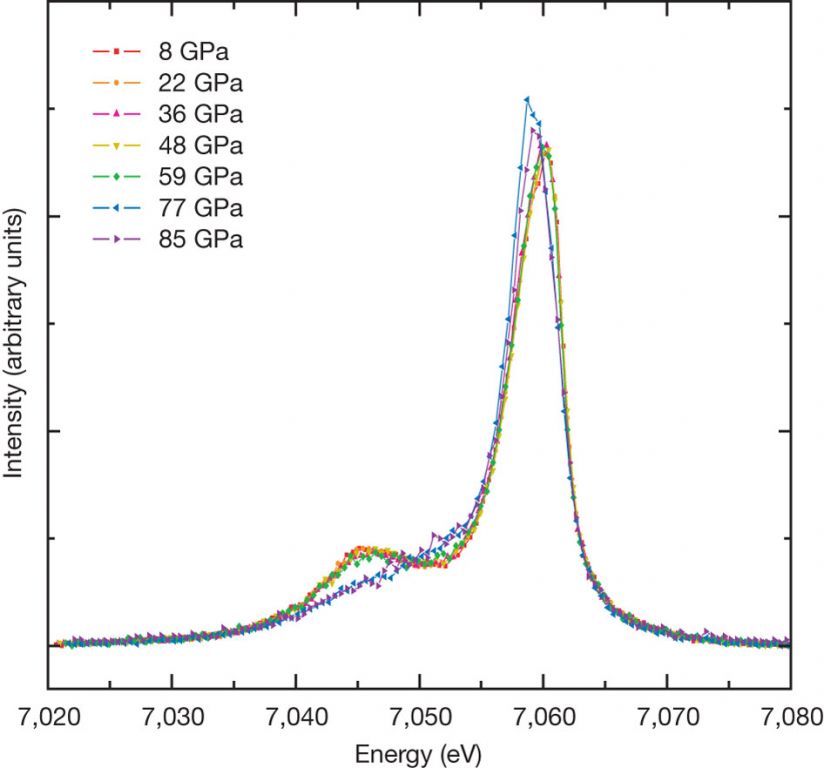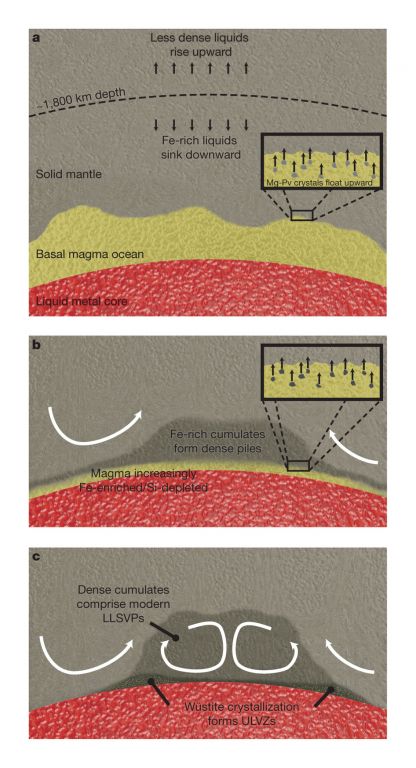博文
地幔深部Fe的自旋态转换以及富Fe硅酸盐熔体
|||
下地幔底部核幔边界之上可能存在着高密度的熔体,这些熔体由于特别富集Fe而比周围地幔物质密度更大,从而可以在这样的极端环境下保持重力稳定。Fe在下地幔中的分配行为伴随着下地幔中Fe的自旋态的转换,即从高自旋态向低自旋态转换,这种行为在下地幔矿物钙钛矿和铁方镁石中已经被广泛观测到。如果这种高低度的富Fe熔体可以在下地幔底部核幔边界之上稳定存在,那么就可能在地球形成演化过程中产生厚达1000km的高密度熔体层,这对于地球内部物质的分异演化以及现在下地幔底部超低速带(ULVZs)的解释具有重要的揭示意义。这一成果发表在最新一期2011年5月12日《Nature》杂志上,正是由发现后钙钛矿(post-perovskite)的日本科学家Kei Hirose小组利用激光加热金刚石压砧(LHDAC)完成了相关实验。(译者注)
Nature原文链接:http://www.nature.com/nature/journal/v473/n7346/full/nature09940.html
Supplementary Information (5.1M):http://www.nature.com/nature/journal/v473/n7346/extref/nature09940-s1.pdf
PDF文档下载:2011-Nature-Spin crossover and iron-rich silicate melt in the Earth’s deep mantle.pdf
熔体与同成分的硅酸盐固相相比具有更大的体积。但是在高压条件下这一差距将会缩小,并且现在普遍推测具有这样一种可能性,那就是,在地球内部(以及其他类地天体)高压条件下大量富集重元素Fe的熔体比固相密度更大(1,2)。这些致密硅酸盐熔体在下地幔底部的出现,将会对其物理化学演化产生重要影响,并可以提供一个统一模型来解释核幔边界区所观测到的一些特征(3)。最近的理论计算(4)以及在浅部地幔条件下对(Mg,Fe)SiO3钙钛矿和熔体之间Fe的分配关系的估计(5-7)表明,在地球最深部地幔高压条件下熔体比固相密度更大,这与冲击波实验分析结果一致(8)。本文我们将Fe分配关系测量扩大到整个地幔压力范围,发现在大于~76 GPa压力时有一个明显突变,导致Fe在熔体中的强烈富集。随后对(Mg0.95Fe0.05)SiO3玻璃的X光发射光谱分析显示在大约70 GPa时有一个自旋态突降(spin collapse),这表明所观测到的Fe分配关系的变化可以用硅酸盐熔体中Fe的自旋态转换(从高自旋态到低自旋态)来解释。这些结果意味着在下地幔~1800 km深度条件下(Mg,Fe)SiO3液相比共存的固相密度更大。在地球刚形成早期,由增生作用(accretion)和内部分异(internal differentiation)所释放的热量可以在固体地幔下面形成一个厚达1000 km的致密熔体层。我们也推测(Mg,Fe)SiO3钙钛矿在深部地幔条件下处于液相线状态,致密岩浆的分异结晶作用(fractional crystallization)会逐渐向富Fe贫Si成分演化,这与地震学上对核幔边界区结构的推测是一致的。
我们的熔融实验是在激光加热金刚石压砧(laser-heated diamond-anvil cell, DAC)上进行的,样品总体成分为(Mg0.89,Fe0.11)2SiO4,压力条件为20-159 GPa。为了避免出现异常热扩散,加热时间控制到比较短(见补充材料),但是这也使我们难于测量熔融温度。不过实验中温度的上下限可以分别由Mg2SiO4液相线温度以及天然橄榄岩的固相线温度来给出(见Methods以及补充材料图1)。从DAC回收的样品用高分辨率场发射电子探针显微分析仪(FE-EPMA)进行了分析。回收样品显示同心结构,这反映了加热过程中的温度分布(Fig.1),与常见的多顶砧实验(5-7)中所观测的结构类似。我们在样品中间温度最高部分总是观测到一个斑点(pocket),它具有非化学计量比的成分,我们将其看作是淬火局部熔体(quenched partial melt)。该淬火熔体的(Mg+Fe)/Si摩尔比随压力增加而增大,从36 GPa时的1.50到159 GPa时的2.56(补充材料图2)。该熔体斑点被一个单相固体层(铁方镁石或者钙钛矿,视压力条件不同)所包围,我们认为这是在降温过程中最先结晶的相(液相线相)(5,7)。

Figure 1: Backscattered electron images and X-ray maps for Si, Mg and Fe for samples recovered from high-pressure melting experiments. a, At 32 GPa, when ferropericlase (Fp) is the liquidus phase; b, at 76 GPa, when perovskite (Pv) is the crystalline phase in contact with the quenched melt pocket; and c, at 159 GPa in the stability field of post-perovskite (PPv). Quenched melt was found at the centre of the sample, where the temperature was highest. Metallic iron was observed at the edge of the laser-heated area in all samples, where a strong temperature gradient existed28. It was also found in the melt pocket, but only above 36 GPa where the liquidus phase was perovskite or post-perovskite. Arrows in a represent the directions of the laser beams for heating. See Supplementary Information for the valence state of iron in the partial melt.
在本研究中,在20-36 GPa时液相线相是铁方镁石(ferropericlase),在更高压力下则逐渐被钙钛矿所取代(在36 GPa时两者同时都与熔体池接触) (Fig.1)。考虑到样品中Mg/Si比值的差异(7),这与橄榄岩成分物质的观测结果(5)一致,其中在31 GPa以上条件下液相线相从铁方镁石变成钙钛矿。尽管实验中并没有做物相鉴定,但是在143-159 GPa条件下的实验中应该会形成后钙钛矿(post-perovskite)。在36 GPa时液相线相从铁方镁石向钙钛矿的转变表明,共熔(eutectic)熔体成分在高压条件下更加富Mg。这与熔体中(Mg+Fe)/Si摩尔比随压力增加而增大的现象是一致的(补充材料图2),尽管熔体成分与熔融程度也是相关的。

Figure 2: Change in Fe-Mg distribution coefficient and calculated density profiles. a, KD = (FePv/MgPv)/(Femelt/Mgmelt) between perovskite (blue circles) or post-perovskite (red squares) and melt; the values drop sharply at pressures above 76 GPa, probably due to the effect of the spin crossover of iron in silicate melt (see Fig. 3). Previous experimental datum obtained at 25 GPa using a multi-anvil apparatus is shown by a grey circle6. Error bars were estimated from uncertainties (1σ) in both solid and liquid compositions. b, Density of the (Mg,Fe)SiO3 liquid coexisting with (Mg0.92Fe0.08)SiO3 perovskite calculated for 4,000 K using the newly obtained Fe-Mg partitioning data. Data for (Mg0.86Fe0.14) O ferropericlase29, Ca-perovskite30 and PREM19 are also shown for comparison. Liq, liquid; Fp, ferro-periclase; CaPv, calcium silicate perovskite; MgPv, magnesium silicate perovskite.
钙钛矿/后钙钛矿和熔体之间的Fe-Mg分配系数KD = ([FePv]/[MgPv])/([Femelt]/[Mgmelt]),在36-159 GPa压力范围内均得到测定(Fig.2a),其中钙钛矿/后钙钛矿为液相线相。尽管淬火熔体斑点含有多价态的Fe(Fig.1b,c),但是我们将高温下所有的Fe均看作为Fe2+(见补充材料)。KD值在73 GPa以下几乎保持恒定不变(大约0.22-0.29)。这与前人在含Al橄榄岩总体成分(5-7)中的测量结果(~0.4)相比要低一些,但是与不含Al的橄榄岩物质(6)在25 GPa条件下所获得的KD=0.304±0.035非常一致。在含Al体系中高KD值应该是由于钙钛矿中的高Fe3+含量引起的(见ref.9)。另一方面,KD在76 GPa时会突降到0.07±0.02(Fig.2a)。随后一直到159 GPa则几乎保持恒定在0.06-0.08。

Figure 3: Evolution of X-ray emission spectra of (Mg0.95Fe0.05)SiO3 glass with increasing pressure. Measurements were conducted at 300 K. All spectra are normalized to transmitted intensity, and shifted so that the weighted average of main (Kβ) plus satellite (Kβ′) emission lines is set to 7,058 eV. The satellite peak decreased slightly at 59 GPa and completely disappeared at 77 GPa, indicating the spin crossover of iron.
为了研究76 GPa以上条件下Fe在熔体中强烈富集的原因,我们在300 K、8-85 GPa条件下对(Mg0.95Fe0.05)SiO3玻璃进行了X光发射光谱分析(Fig.3)。在低压下,Fe的Kβ′ 峰(satellite peak)在7045 eV非常明显,指示玻璃样品中的高自旋态的Fe2+。这一峰在59 GPa时会减弱,而在77 GPa时会消失。这表明了二价Fe中的自旋态转换。因为玻璃是液态的一个很好的类似物,这样一个Fe的高自旋向低自旋态的转换也可以在相似压力条件下的熔体中产生,因此为熔体中所观测到的Fe富集的突变而提供了一种解释(见refs. 10, 11)。确实在我们的玻璃样品中所观测到的自旋态转换的压力范围与KD急剧变化的压力(Fig.2a)是相符的。我们的熔体比(Mg0.95Fe0.05)SiO3玻璃具有更高的Mg/Si比值以及FeO含量;但是Mg2SiO4流体中所计算的平均Mg-O和Si-O配位数(12)与下地幔压力条件下MgSiO3流体中的值(13)非常相近。因此,与Mg/Fe-O配位相关的自旋态转换压力不会伴随着熔体中Mg/Si比值从1变化到2而产生明显偏移。理论研究(14,15)表明,当Fe浓度很低时(低于~20%),Fe含量并不会改变自旋态转换的压力范围,因为Fe-Fe相互作用是可以忽略的。多顶砧实验(16)结果表明,在自旋态转换开始时,钙钛矿和铁方镁石之间Fe的分配会产生急剧变化,这与我们的观测具有可比性。

Figure 4: Evolution and crystallization of dense melts in the deep mantle. a, During Earth's early history, any melts that form below ~1,800 km depth sink and accumulate at the base of the mantle, while any crystals that form owing to cooling of this dense magma will rise upward into the solid mantle. b, Fe-poor perovskite crystallization leaves a residual liquid enriched in FeO and depleted in SiO2, and crystals forming from this evolved liquid may become dense enough to form thermo-chemical piles at the base of the solid mantle. c, The final stage of crystallization involves a composition close to wüstite, leaving behind a very dense thin layer that is consistent with the seismic properties inferred inside ULVZs. White arrows indicate schematic flow patterns in the convecting solid mantle.
Fe分配关系的巨大变化表明在1800 km深度以下熔体会变得更加致密。我们计算了与(Mg0.92Fe0.08)SiO3钙钛矿(地幔岩下地幔的代表成分(16,17))达到平衡的(Mg,Fe)SiO3流体, 在4000K条件下随压力变化的密度(Fig.2b)。为简化起见,在75 GPa以下我们使用KD=0.25,在更高压力下我们使用KD=0.07。MgSiO3流体的摩尔体积根据最近的第一性原理计算结果(4)获得,Fe的作用对于流体相和固相(钙钛矿)假设是相同的(4,18)。但是(Mg,Fe)SiO3熔体在75 GPa以下时与任何典型下地幔矿物相比都是具有浮力的,而在更高压条件下则会突然变得密度更大。在地幔底部与初始参考地球模型(PREM)(19)的差距达到8%。本实验中熔体的Mg/Si比值比MgSiO3高(补充材料图2)。根据前人的冲击波压缩实验(8),这种高(Mg+Fe)/Si熔体可能比上面所讨论的(Mg,Fe)SiO3熔体密度更大,从而表明熔体和固体之间的密度转换可能发生在比1800 km更浅的深度。尽管有关熔体在地幔底部的详细情况并不是十分清楚,但是我们的结果为下地幔中可能存在的厚达1000 km的稳定熔体层提供了约束条件(Fig.4)。
Labresse等(3)已经提出了一个模型,在地球形成不久所产生的致密熔体,可以构成一个相当大的“基底岩浆海”(basal magma ocean, BMO),它在几十亿年中缓慢结晶,其速率由上覆固体地幔中相对缓慢的固相对流所控制。我们的实验结果为固体地幔下高达1000 km的BMO的重力稳定性提供了一个新的物理证据,并且上面所推测的最大的可能厚度与BMO假说在广范围来说是一致的。例如,一个1000 km厚的BMO可以构成地幔1/4的质量;分异结晶作用以及冷却过程中残余流体中热量所产生的不相容元素(如U,Th)的隔离,可以解释“丢失”的球粒陨石成分,这些物质可能被隔离在地幔中的某个储库中(20)。我们的实验结果也可以帮助我们对BMO的性质以及其化学演化过程随时间的变化做进一步的推测。
正如上文所提到的,我们的结果说明,(Mg,Fe)SiO3钙钛矿是从熔体中最先结晶出来的相,并具有较广的(Mg+Fe)/Si比值;对于核幔边界条件下(Mg+Fe)/Si≈2.5的贫Si熔体来说依然是这样的(补充材料Fig.2)。这充分说明,BMO冷却过程主要是以钙钛矿的结晶作用为特点,其他的相如(Mg,Fe)O镁方铁矿 (magnesiowustite)只在相对较晚的时期结晶。另外,BMO中形成的钙钛矿晶体将会相对亏损Fe,并漂浮到1800 km深度以下的岩浆区的顶部(Fig.4),因为其Fe/Mg分配KD值较低。由此,我们可以推断残余岩浆将会向富FeO贫SiO2成分演化(即接近于方铁矿的成分),随时间密度变得更大,而且可能会保留相当量的不相容挥发性物质。
经过如上文所讨论的分异结晶演化,同样也可以影响从BMO所形成的堆积岩的成分。尤其是当从越来越富Fe的岩浆中结晶出来时,堆积岩会随时间变得更加富Fe密度更大。这些高密度堆积岩最终将可以保持稳定而不会被地幔对流所带走,并在地幔底部集中形成热化学堆积(Fig.4)。这些致密固体物质的堆积,大约比平均地幔密度高2-3%并构成~2%的总体地幔体积,可以解释太平洋和非洲地区(21)下面地幔底部两个巨大的低剪切波速省(low-sheaer-wave velocity provinces, LLSVPs);这些高密度物质的富Fe成分与这些异常(22)大小是一致的。
BMO中更高程度的结晶作用也可以在核幔边界之上的薄层中产生一些高密度残余体补丁,这将可以解释超低速带(ultralow-velocity zones, ULVZs)(23)的出现以及地震波速特征。这些物质在地质历史时期里可以保持在或接近固相线,因为参与流体将会隔离不相容物质,相应地也会降低熔融温度。那么后期富方铁矿的堆积岩从富Fe贫Si熔体中结晶出来将会产生一个高密度固相层,即使没有熔体(24),其地震波特征同样与来自ULVZ的地震反射仍然是一致的。BMO模型以及我们实验所推测的成分演化过程,与两种可能性都是相容的。另外一种可能,有助于解释为什么不同地区的ULVZs并不总是显示相同的地震特征(25),那就是在一些ULVZs中间隙中的熔体已经完全抽干,留下一个强烈富集方铁矿的不含熔体的固相岩石。在另外一些ULVZs中,由于周围地幔中存在不同的动力学条件,上覆地幔流粘度耦合作用所产生的这些糊状残余体的连续扰动,将会阻止岩石的固结和熔体的分离(26)。不含熔体富集方铁矿的ULVZ和固有的糊状的ULVZ之间,我们所预计观测到的主要区别就是,剪切波速的降低幅度,在糊状ULVZs中降低幅度更大(27)。
参考文献:
- Stolper, E., Walker, D., Hager, B. H. & Hays, J. F. Melt segregation from partially molten source regions: the importance of melt density and source region size. J. Geophys. Res. 86, 6261–6271 (1981) ChemPort ISI Article Show context
- Agee, C. B. Crystal-liquid density inversions in terrestrial and lunar magmas. Phys. Earth Planet. Inter. 107, 63–74 (1998) ChemPort ISI Article Show context
- Labrosse, S., Hernlund, J. W. & Coltice, N. A crystallizing dense magma ocean at the base of the Earth's mantle. Nature 450, 866–869 (2007) ChemPort ISI PubMed Article Show context
- Stixrude, L. et al. Thermodynamics of silicate liquids in the deep Earth. Earth Planet. Sci. Lett. 278, 226–232 (2009) ChemPort ISI Article Show context
- Ito, E., Kubo, A., Katsura, T. & Walter, M. J. Melting experiments of mantle materials under lower mantle conditions with implications for magma ocean differentiation. Phys. Earth Planet. Inter. 143–144, 397–406 (2004) Show context
- Corgne, A. et al. Silicate perovskite-melt partitioning of trace elements and geochemical signature of a deep perovskitic reservoir. Geochim. Cosmochim. Acta 69, 485–496 (2005) ChemPort ISI Article Show context
- Liebske, C. et al. Compositional effects on element partitioning between Mg-silicate perovskite and silicate melts. Contrib. Mineral. Petrol. 149, 113–128 (2005) ChemPort ISI Article Show context
- Mosenfelder, J. L., Asimov, P. D. & Ahrens, T. J. Thermodynamic properties of Mg2SiO4 liquid at ultra-high pressures from shock measurements to 200 GPa on forsterite and wadsleyite. J. Geophys. Res. 112 B06208 doi:10.1029/2006JB004364 (2007) ChemPort Article Show context
- McCammon, C. Perovskite as a possible sink for ferric iron in the lower mantle. Nature 387, 694–696 (1997) ChemPort ISI Article Show context
- Badro, J. et al. Iron partitioning in Earth’s mantle: toward a deep lower mantle discontinuity. Science 300, 789–791 (2003) ChemPort ISI PubMed Article Show context
- Auzende, A.-L. et al. Element partitioning between magnesium silicate perovskite and ferropericlase: new insights into bulk lower-mantle geochemistry. Earth Planet. Sci. Lett. 269, 164–174 (2008) ChemPort ISI Article Show context
- de Koker, N. P., Stixrude, L. & Karki, B. B. Thermodynamics, structure, dynamics, and freezing of Mg2SiO4 liquid at high pressure. Geochim. Cosmochim. Acta 72, 1427–1441 (2008) ChemPort ISI Article Show context
- Karki, B. B. First-principles molecular dynamics simulations of silicate melts: structural and dynamical properties. Rev. Mineral. Geochem. 71, 355–389 (2010) ChemPort ISI Article Show context
- Tsuchiya, T., Wentzcovitch, R. M., da Silva, C. R. S. & de Gironcoli, S. Spin transition in magnesiowüstite in Earth's lower mantle. Phys. Rev. Lett. 96, 198501 (2006) ChemPort PubMed Article Show context
- Bengtson, A., Persson, K. & Morgan, D. Ab initio study of the composition dependence of the pressure-induced spin crossover in perovskite (Mg1-x,Fex)SiO3. Earth Planet. Sci. Lett. 265, 535–545 (2008) ChemPort ISI Article Show context
- Irifune, T. et al. Iron partitioning and density change of pyrolite in Earth’s lower mantle. Science 327, 193–195 (2010) ChemPort ISI PubMed Article Show context
- Hirose, K. Phase transition in pyrolitic mantle around 670-km depth: implications for upwelling of plumes from the lower mantle. J. Geophys. Res. 107 2078 doi:10.1029/2001JB000597 (2002) Article Show context
- Lundin, S. et al. Effect of Fe on the equation of state of mantle silicate perovskite over 1 Mbar. Phys. Earth Planet. Inter. 168, 97–102 (2008) ChemPort ISI Article Show context
- Dziewonski, A. M. & Anderson, D. L. Preliminary reference Earth model. Phys. Earth Planet. Inter. 25, 297–356 (1981) ISI Article Show context
- Hofmann, A. W. Mantle geochemistry: the message from oceanic volcanism. Nature 385, 219–229 (1997) ChemPort ISI Article Show context
- Hernlund, J. W. & Houser, C. On the distribution of seismic velocities in Earth’s deep mantle. Earth Planet. Sci. Lett. 265, 423–437 (2008) ChemPort ISI Article Show context
- Cobden, L. et al. Thermochemical interpretation of 1-D seismic data for the lower mantle: the significance of nonadiabatic thermal gradients and compositional heterogeneity. J. Geophys. Res. 114 B11309 doi:10.1029/2008JB006262 (2009) ChemPort Article Show context
- Williams, Q. & Garnero, E. J. Seismic evidence for partial melt at the base of Earth's mantle. Science 273, 1528–1530 (1996) ChemPort ISI Article Show context
- Wicks, J. K., Jackson, J. M. & Sturhahn, W. Very low sound velocities in iron-rich (Mg,Fe)O: implications for the core-mantle boundary region. Geophys. Res. Lett. 37 L15304 doi:10.1029/2010GL043689 (2010) ChemPort Article Show context
- Thorne, M. S. & Garnero, E. J. Inferences on ultralow-velocity zone structure from a global analysis of SPdKS waves. J. Geophys. Res. 109 B08301 doi:10.1029/2004JB003010 (2004) Article Show context
- Hernlund, J. W. & Jellinek, A. M. Dynamics and structure of a stirred partially molten ultralow velocity zone. Earth Planet. Sci. Lett. 296, 1–8 (2010) ChemPort ISI Article Show context
- Hier-Majumder, S. Influence of contiguity on seismic velocities of partially molten aggregates. J. Geophys. Res. 113 B12205 doi:10.1029/2008JB005662 (2008) Article Show context
- Fialin, M., Catillon, G. & Andrault, D. Disproportionation of Fe2+ in Al-free silicate perovskite in the laser heated diamond anvil cell as recorded by electron probe microanalysis of oxygen. Phys. Chem. Miner. 36, 183–191 (2009) ChemPort ISI Article Show context
- Komabayashi, T. et al. High-temperature compression of ferropericlase and the effect of temperature on iron spin transition. Earth Planet. Sci. Lett. 297, 691–699 (2010) ChemPort ISI Article Show context
- Ricolleau, A. et al. Density profile of pyrolite under the lower mantle conditions. Geophys. Res. Lett. 36 L06302 doi:10.1029/2008GL036759 (2009) ChemPort Article Show context
https://blog.sciencenet.cn/blog-92454-444059.html
上一篇:中国东北存在地幔柱吗?
下一篇:地球内核的熔融作用 Melting of the Earth’s inner core